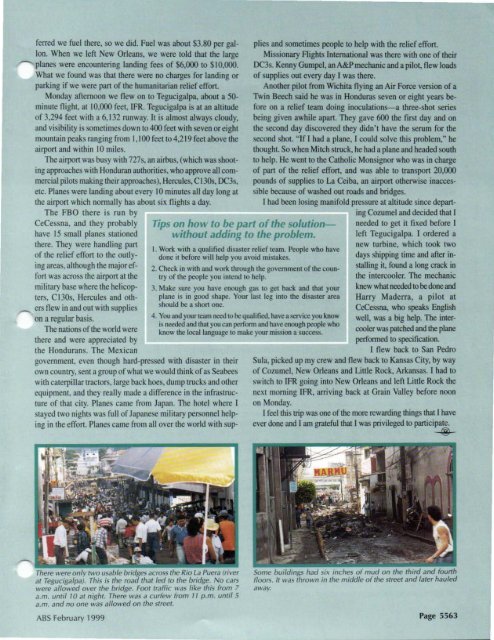You also want an ePaper? Increase the reach of your titles
YUMPU automatically turns print PDFs into web optimized ePapers that Google loves.
ferred we fuel there, so we did. Fuel was about $3.80 per galIon. When we left New Orleans, we were told that the large-----. planes were encountering landing fees of $6,000 to $10,000.What we found was that there were no charges for landing orparking if we were pan of the humanitarian relief effon.Monday afternoon we flew on to Tegucigalpa, about a 50-minute flight, at 10,000 feet, !FR. Tegucigalpa is at an altitudeof 3,294 feet with a 6,132 runway. It is almost always cloudy,and visibility is sometimes down to 400 feet with seven or eightmountain peaks ranging from I, I 00 feet to 4,219 feet above theairpon and within 10 miles.The airpon was busy with 727s, an airbus, (which was shootingapproaches with Honduran authorities, who approve all commercialpilots making their approaches), Hercules, C 130s, DC3s,etc. Planes were landing about every 10 minutes all day long atthe airpon which normally has about six flights a day._The FBO there is run byCeCessna, and they probablyhave IS small planes stationedthere. They were handling panof the relief effort to the outlyingareas, although the major effonwas across the airport at themilitary base where the helicopters,C 130s. Hercules and oth-ers flew in and out with supplieson a regular basis.The nations of the world werethere and were appreciated bythe Honduran s. The Mexicangovernment, even though hard-pressed with disaster in theirown country, sent a gro up of what we would think of as Seabeeswith caterpillar tractors, large back hoes, dump trucks and otherequipment, and they really made a difference in the infrastructureof that city. Planes came from Japan. The hotel where Istayed two nights was full of Japanese military personnel helpingin the effort. Planes came fro m all over the world with sup-Tips on how to be part of the solutionwithoutadding to the problem.I . Work with a qualified disaster relief team. People who havedone it before will help you avoid mistakes.2. Check in with and work through the government of the countryof the people you intend to help.3. Make sure you have enough gas to get back and that yourplane is in good shape. Your last leg into the disaster areashould be a short one.4. You and your team need to be qualified, have a service you knowis needed and that you can perfonn and have enough people whoknow the local language to make your mission a success.plies and sometimes people to help with the relief effon.Missionary Flights International was there with one of theirDC3s. Kenny Gumpel, an A&P mechanic and a pilo~ flew loadsof supplies out every day I was there.Another pilot from Wichita flying an Air Force version of aTwin Beech said he was in Honduras seven or eight years beforeon a relief team doing inoculations-a three-shot seriesbeing given awhile apart. They gave 600 the first day and onthe second day discovered they didn't have the serum for thesecond shot. "If I had a plane, I could solve this problem," hethought. So when Mitch struck, he had a plane and headed southto help. He went to the Catholic Monsignor who was in chargeof pan of the relief effon, and was able to transpon 20,000pounds of supplies to La Ceiba, an airpon otherwise inaccessiblebecause of washed out roads and bridges.I had been losing manifold pressure at altitude since departing Cozumel and decided that Ineeded to get it fixed before Ileft Tegucigalpa. I ordered anew turbine, which took twodays shipping time and after installingit, found a long crack inthe intercooler. The mechanicknew what needed to be done andHarry Maderra, a pilot atCeCessna, who speaks Englishwell, was a big help. The intercoolerwas patched and the planeperformed to specification.1 fl ew back to San PedroSula, picked up my crew and flew back to Kansas City, by wayof Cozumel, New Orleans and Little Rock, Arkansas. I had toswitch to lFR going into New Orleans and left Little Rock thenext morning IFR, arriving back at Grain Valley before noonon Monday.I feel this trip was one of the more rewarding things that I haveever done and I am grateful that I was privileged to participate.~There were only two usable bridges across Rio La Puera (riverat Tegucigalpa). This is the ro"d that led to the bridge. No carswere allowed over the bridge. Foot traffic was like this from 7a.m. untitl0 at night. There was a curfew from 11 p.m. untitSa.m. and no one was allowed on the street.ABS <strong>February</strong> <strong>1999</strong>Some buildings had six inches of mud on the third andfloors. It was thrown in the middle of the street and later hauledaway.Page 5563
















